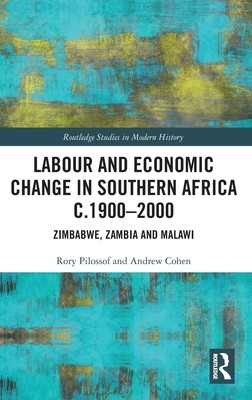
- We will send in 10–14 business days.
- Author: Rory Pilossof
- Publisher: Routledge
- ISBN-10: 0367467763
- ISBN-13: 9780367467760
- Format: 15.6 x 23.4 x 1.4 cm, hardcover
- Language: English
- SAVE -10% with code: EXTRA
Labour and Economic Change in Southern Africa C.1900-2000 (e-book) (used book) | bookbook.eu
Reviews
Description
This book explores the social and economic development of Zimbabwe, Zambia and Malawi over the course of the twentieth century.
These three countries have long shared and interconnected pasts. All three were drawn into the British Empire at a similar time and the formation of the ill-fated Federation of Rhodesia and Nyasaland formally linked these countries together for a decade in the mid-twentieth century. This formal political relationship created dynamics that resulted in yet closer economic and social links. After Federation, the economic realities of industry, transport and labour supplies meant that these three countries continued to be intricately interconnected. Yet despite these connected pasts, comparative work on the economic histories of Malawi, Zambia and Zimbabwe, and how these change over time, is rare. This book addresses the gap by providing the first comprehensive collection of labour and census data across the twentieth century for these three countries. The different economic models and performances of these states offer good comparison, allowing researchers to look at different models of development, and how these played out over the long-term.
The book provides data on population growth and change, industrial and occupational structure, and the various shifts in what the economically active population did. It will be useful for historians, economists, development studies scholars and non-governmental organisations working on twentieth-century and contemporary southern Africa.
EXTRA 10 % discount with code: EXTRA
The promotion ends in 20d.14:27:36
The discount code is valid when purchasing from 10 €. Discounts do not stack.
- Author: Rory Pilossof
- Publisher: Routledge
- ISBN-10: 0367467763
- ISBN-13: 9780367467760
- Format: 15.6 x 23.4 x 1.4 cm, hardcover
- Language: English English
This book explores the social and economic development of Zimbabwe, Zambia and Malawi over the course of the twentieth century.
These three countries have long shared and interconnected pasts. All three were drawn into the British Empire at a similar time and the formation of the ill-fated Federation of Rhodesia and Nyasaland formally linked these countries together for a decade in the mid-twentieth century. This formal political relationship created dynamics that resulted in yet closer economic and social links. After Federation, the economic realities of industry, transport and labour supplies meant that these three countries continued to be intricately interconnected. Yet despite these connected pasts, comparative work on the economic histories of Malawi, Zambia and Zimbabwe, and how these change over time, is rare. This book addresses the gap by providing the first comprehensive collection of labour and census data across the twentieth century for these three countries. The different economic models and performances of these states offer good comparison, allowing researchers to look at different models of development, and how these played out over the long-term.
The book provides data on population growth and change, industrial and occupational structure, and the various shifts in what the economically active population did. It will be useful for historians, economists, development studies scholars and non-governmental organisations working on twentieth-century and contemporary southern Africa.


Reviews